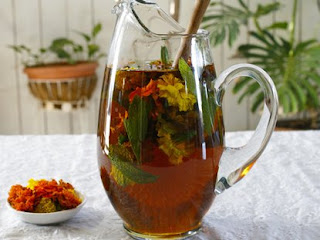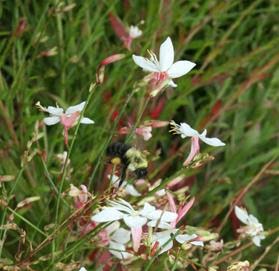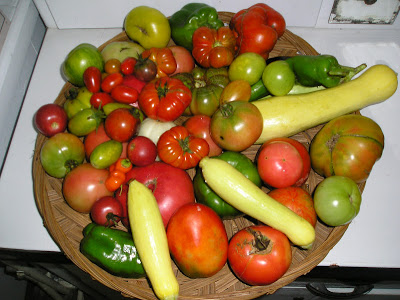 |
| Refreshing Herbal Tea (Photo: Carol Kagan) |
Summer – hot, humid, sun-baking. Working in the garden, mowing, playing your favorite sport or marking off honey-do list items brings out the sweat.
The weather man, newspaper and doctors all say to stay hydrated. We need to drink liquids but it’s important to limit caffeine and alcohol intake.
What to do? Drink herbal teas!
Herbal iced teas are refreshing. Serve with ice, a fresh herbal sprig or slice of fruit, sit back and take a break.
The teas are healthy and caffeine-free. Caffeine, a diuretic, can worsen dehydration and the stimulation can overwork what may already be a stressed cardio system. Please note that green tea, although considered to have healthful benefits, contains caffeine.
 |
| Include fresh fruit in your herbal iced tea instead of sugar |
It is best to use non-metallic containers for making tea as metal can affect the taste. Use cold water to make tea. Be careful when adding boiling or hot water to glass or ceramic containers. Add water with the container in the sink and avoid breakage. For iced tea, the amount of tea is increased over that of hot tea since the tea will be diluted by the ice that is added.
 For one cup with dried herbs, add boiling water to 2 Tablespoons of herbs. Dried herbs have a more concentrated taste than fresh. For fresh herbs, use 3 Tablespoons of finely minced leaves. Add boiling water and steep for 3-5 minutes. Strain and let the tea cool. Pour over ice and serve with an herbal sprig or slice of fruit.
For one cup with dried herbs, add boiling water to 2 Tablespoons of herbs. Dried herbs have a more concentrated taste than fresh. For fresh herbs, use 3 Tablespoons of finely minced leaves. Add boiling water and steep for 3-5 minutes. Strain and let the tea cool. Pour over ice and serve with an herbal sprig or slice of fruit.
Consider using a stevia leaf from your plant for sweetner. Stevia is said to be over 30 times sweeter than sugar. Try one-eight of a teaspoon of the herb per cup and adjust accordingly. Two Tablespoons approximately equals one cup of sugar.
For a pitcher, rinse the pitcher with hot water. Add boiling water to the tea using the same measurements but add “one for the pot.” Steep for 3-5 minutes, strain and let cool. Add ice just before serving. Fruit or herbal sprigs added to the pitcher are a nice touch.
Although using solar power to make sun tea is popular, brewing sun tea for long periods of time may encourage the growth of bacteria especially if using tap water. If you make herbal sun tea, make sure the container is clean (and clean between uses). Check the position of the container during brewing to make sure it remains in the sun. Refrigerate the tea as soon as steeped and use within 1-2 days.
In early American times, when the colonists refrained from drinking English teas in protest of taxes, they turned to teas made from native bushes and herbs such as strawberry and raspberry leaves, mints, clover and bee balm.
 |
| Monarda didyma - Oswego Tea |
Marigold and Mint Tea
10 cups water
3 herbal tea bags (try mint, lemon, ginger) or decaffeinated green tea
2 star anise
1 cup fresh mint leaves
1 cup edible marigold petals (pluck and wash the flower heads thoroughly)
1 cup sugar or 2 Tbsps. stevia
Bring 4 cups of water to a boil, add the tea bags and anise stars. Remove from the stove and steep for 1- minutes. Add the mint and marigold petals and steep for another hour. Remove the tea bags, anise, mint and marigold leaves.
In a separate pan heat 1 cup of water and 1 cup of sugar (or stevia leaves) and stir until dissolved. Remove from the stove and cool.
To serve, combine the steeped tea, sweet syrup and remaining 5 cups of water in a pitcher or other glass container. Refresh with fresh mint and marigold petals. Refrigerate overnight. Serve over ice and garnish with mint and marigold petals.
 |
| Marigold and Mint Tea |
Some Plants for Teas
Dill - Savory – Blackberry - Bee balm – Sage
Lemongrass - Mints - Marjoram - Lemon verbena
Rosemary – Borage - Lemon balm
Thyme - Strawberry - Chamomile
Winter – cold and stormy. But anyone shoveling snow can confirm that we still sweat in winter and we need to drink liquids. Follow the same directions as above to make a cup or pot of hot tea, reducing the measurements to 1 Tablespoon of dried herbs and 2 Tablespoons of fresh minced herbs for a cup of tea.
When planning your garden this year, include some tea herbs for both summer and winter enjoyment.
Other links of interest about herbal teas:
San Diego State University: The Enjoyment of Tea
Herb Society of America: Fiesta in Lucinda’s Garden
National Institutes of Health: Herbal Medicine
National Institutes of Health: Green Tea Fact Sheet
Colorado State University Extension: Is Sun Tea Safe?


























